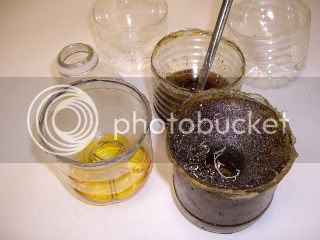mklotz
Well-Known Member
This is an old idea - my Dad made one eons ago - but it may be of interest to some of you. I know that it was a hit with some of the members of our club.
If you use a can and brush to apply cutting oil on the lathe, you probably have spilled the can once or twice. This can can prevent those messy spills.
It consists of nothing more than a can (e.g., tuna can) with a metal lid soldered onto it. In the middle of the lid is soldered an open-ended tube (copper plumbing tube works well) which extends into the interior of the can. The can is then filled with a small amount of cutting oil such that, as the attached sketch shows, when the can is laid on its side or turned upside down, no oil can escape. Your oil brush goes into the central tube to access the oil.
Designing such a can is an exercise in elementary mathematics. I wrote a program to do it but most of you won't want to get that deeply into it, I suspect. Simply make up something that looks reasonable. Fill it with water and try turning it to different attitudes over the sink until no more water comes out. The water remaining in the can will tell you how much oil you can put into it and have it remain unspillable.

If you use a can and brush to apply cutting oil on the lathe, you probably have spilled the can once or twice. This can can prevent those messy spills.
It consists of nothing more than a can (e.g., tuna can) with a metal lid soldered onto it. In the middle of the lid is soldered an open-ended tube (copper plumbing tube works well) which extends into the interior of the can. The can is then filled with a small amount of cutting oil such that, as the attached sketch shows, when the can is laid on its side or turned upside down, no oil can escape. Your oil brush goes into the central tube to access the oil.
Designing such a can is an exercise in elementary mathematics. I wrote a program to do it but most of you won't want to get that deeply into it, I suspect. Simply make up something that looks reasonable. Fill it with water and try turning it to different attitudes over the sink until no more water comes out. The water remaining in the can will tell you how much oil you can put into it and have it remain unspillable.








